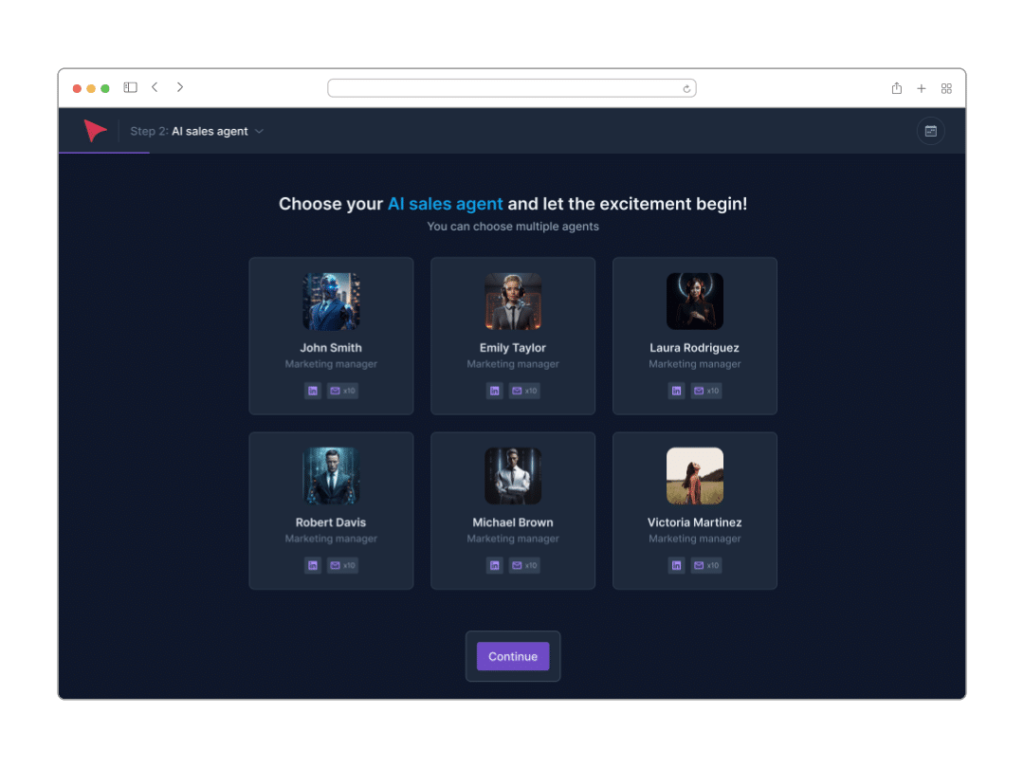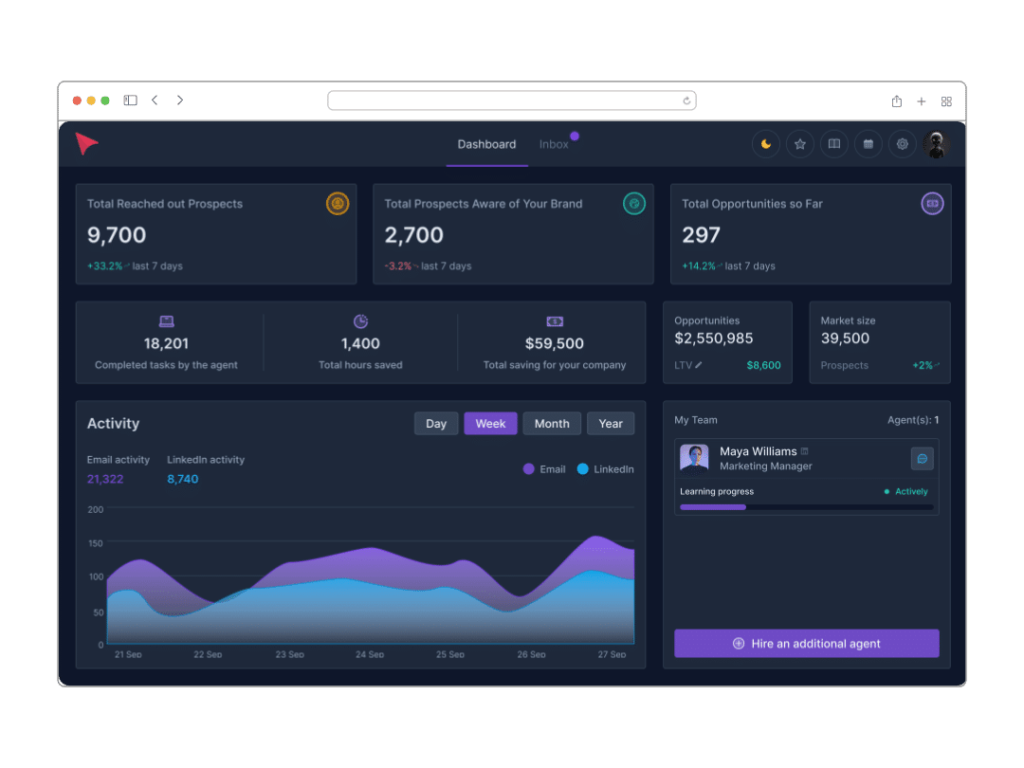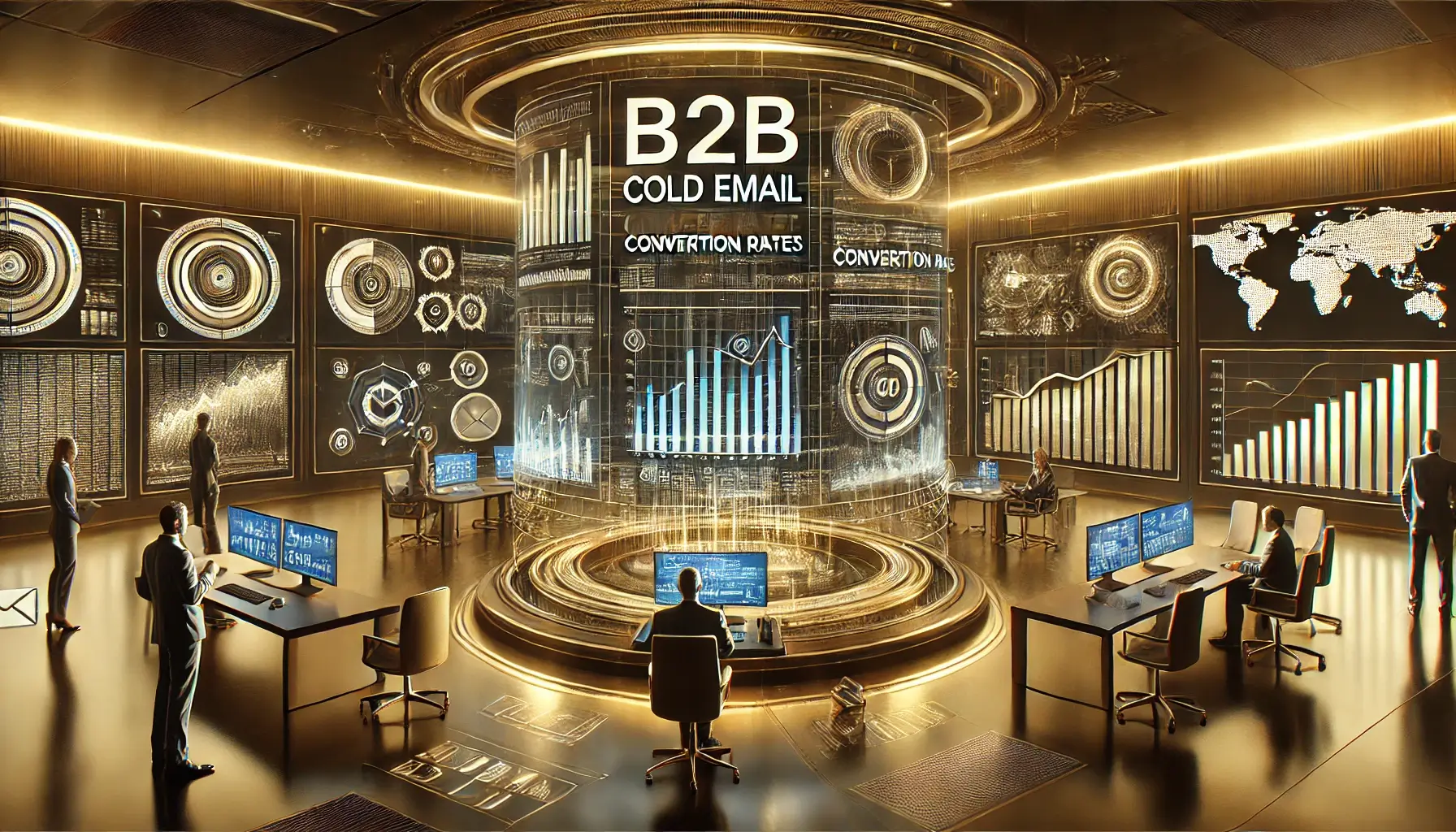Cold emailing is like walking up to a stranger at a party and striking up a conversation. Except in this case, the party is the vast digital landscape, and your conversation starter is a carefully crafted email landing in someone’s inbox. It’s the art of reaching out to potential clients who’ve never heard of you, with the hope of turning that ice-cold lead into a red-hot opportunity.
Now, you might be thinking, “Does this actually work?” Well, here’s a nugget for you: According to a study by Mailchimp, the average open rate for cold emails in the business and finance industry is 21.56%. That’s one in five people potentially giving your message a chance. Not too shabby, right?
But here’s where it gets really interesting. In the B2B world, cold emailing isn’t just a tactic—it’s a lifeline. As Ryan Robinson, a content marketing consultant, puts it, “Cold email is still the most effective way to generate new B2B sales leads, hands down.” And he’s not alone in thinking this. A whopping 89% of marketers say that email is their primary channel for lead generation.
So, whether you’re a startup looking to make your first big sale or an established company hunting for new clients, cold emailing could be your secret weapon. It’s cost-effective, scalable, and when done right, it can open doors you didn’t even know existed.
Ready to dive in and learn how to turn those cold emails into hot leads? Let’s get started!
Understanding Cold Email Conversion Rates
How to Calculate Cold Email Conversion Rates
Calculating your cold email conversion rate is crucial for measuring the success of your campaigns and identifying areas for improvement. Here’s how to do it:
- Define Your Conversion Goal. First, determine what action you want recipients to take. This could be replying to your email, clicking a link, scheduling a call, or making a purchase.
- Track Your Numbers:
- Number of emails sent
- Number of emails delivered (excluding bounces)
- Number of emails opened
- Number of conversions (based on your defined goal)
Calculate Different Conversion Rates
1) Overall Conversion Rate:
(Number of Conversions / Number of Emails Delivered) x 100
Example: If you sent 1000 emails, 950 were delivered, and 20 converted:
(20 / 950) x 100 = 2.11% conversion rate
2) Open-to-Conversion Rate:
(Number of Conversions / Number of Emails Opened) x 100
Example: If 200 emails were opened and 20 converted:
(20 / 200) x 100 = 10% open-to-conversion rate
3) Click-to-Conversion Rate (if applicable):
(Number of Conversions / Number of Clicks) x 100
Example: If 50 people clicked your link and 20 converted:
(20 / 50) x 100 = 40% click-to-conversion rate
Typical Conversion Rates Across Industries
Cold email conversion rates can vary significantly across industries. Here’s a breakdown of average rates:
- Software & Technology: 1.7% – 2.5%
- Marketing & Advertising: 2.0% – 3.0%
- Financial Services: 1.5% – 2.2%
- Healthcare: 1.8% – 2.6%
- Manufacturing: 1.4% – 2.1%
- Real Estate: 1.9% – 2.8%
- E-commerce: 1.6% – 2.4%
- Professional Services: 2.1% – 3.1%
For B2B specifically:
- Average open rate: 15.1%
- Average click-through rate: 3.2%
- Average response rate: 1.7%
- Average conversion rate: 0.3% – 0.5%
Benchmarks Businesses Should Aim For
While industry averages provide a baseline, top-performing businesses often aim higher:
- Open rate: 30-40%
- Click-through rate: 5-10%
- Response rate: 5-15%
- Conversion rate: 1-5%
Remember, these are ambitious targets. Even small improvements over industry averages can significantly impact your bottom line.
Factors Affecting Conversion Rates
Several factors can influence your cold email conversion rates:
- Email Quality. Well-crafted, personalized emails tend to perform better.
- List Quality. Properly segmented and up-to-date email lists yield higher conversion rates.
- Subject Line. Compelling subject lines can dramatically improve open rates.
- Sender Reputation. A good sender score improves deliverability and, consequently, conversion rates.
- Timing. Sending emails at optimal times can increase open and response rates.
- Follow-up Strategy. Consistent, well-timed follow-ups can boost overall conversion rates.
- Call-to-Action (CTA). Clear, compelling CTAs improve click-through and conversion rates.
- Industry and Target Audience. Some industries and audiences are more receptive to cold emails than others.
- Email Design and Format. Mobile-friendly, visually appealing emails tend to perform better.
- Value Proposition. A clear, strong value proposition can significantly increase response and conversion rates.
Why Cold Email Conversion Rates Are Often Low
Common Mistakes in Cold Emailing
- Poor Targeting. Sending emails to a poorly defined audience or using outdated contact lists.
- Example: A B2B software company emailing small local restaurants about enterprise-level solutions.
- Generic Content. Using one-size-fits-all messaging that fails to resonate with recipients.
- Example: “Dear Sir/Madam, we offer the best services in the industry…”
- Weak Subject Lines. Failing to capture attention or interest in the inbox.
- Example: “Follow up” or “Checking in” as subject lines.
- Lack of Value Proposition. Not clearly communicating why the recipient should care or respond.
- Example: Focusing on product features without explaining benefits or solving pain points.
- Poor Timing. Sending emails at inopportune times or frequencies.
- Example: Sending B2B emails on weekends or late at night.
- Neglecting Mobile Optimization. Not considering that over 50% of emails are opened on mobile devices.
- Example: Using small fonts or large images that don’t render well on smartphones.
- Ignoring Email Regulations. Not complying with laws like CAN-SPAM or GDPR.
- Example: Not including an unsubscribe option or sending to people who haven’t opted in.
Challenges in Personalization at Scale
- Data Limitations. Lack of comprehensive, accurate data about prospects.
- Challenge: Gathering enough relevant information to personalize effectively for thousands of recipients.
- Technology Constraints. Inadequate tools or systems for large-scale personalization.
- Challenge: Implementing sophisticated personalization without slowing down the email creation process.
- Content Creation Bottleneck. Difficulty in producing varied, personalized content at scale.
- Challenge: Writing unique, relevant content for different segments without resorting to obvious templates.
- Balancing Automation and Authenticity. Maintaining a personal touch while using automation.
- Challenge: Avoiding the “uncanny valley” where emails feel almost personal but not quite authentic.
- Segmentation Complexity. Effectively dividing a large audience into meaningful segments.
- Challenge: Creating segments that are specific enough for personalization but broad enough to be manageable.
Recipient Fatigue and Inbox Overload
- Email Volume. The average office worker receives 121 emails per day.
- Impact: Your cold email is competing with numerous others for attention.
- Attention Span. The average human attention span has dropped to 8 seconds.
- Impact: Recipients make split-second decisions about whether to engage with an email.
- Inbox Management Practices. Use of filters, tabs, and spam folders.
- Impact: Cold emails often get automatically sorted away from the primary inbox.
- “Cold Email Blindness”. Recipients becoming desensitized to common cold email tactics.
- Impact: Even well-crafted emails might be ignored due to fatigue from similar approaches.
- Privacy Concerns. Increasing wariness about data privacy and unsolicited communications.
- Impact: Recipients may be less likely to engage with emails from unknown senders.
- Work-Life Balance. Professionals trying to reduce email checking outside work hours.
- Impact: Reduced windows of opportunity for your email to be seen and acted upon.
10 Best Practices for Enhancing Cold Email Conversion Rates
1. Craft Compelling Subject Lines
Your subject line is the gatekeeper of your email’s success. It’s the difference between “Read Now” and “Delete Immediately.” The key is to pique curiosity without sounding like clickbait.
Try personalizing with the recipient’s name or company: “John, quick question about Acme’s marketing strategy.” Or create a sense of urgency: “Limited spots for exclusive webinar on AI in Marketing.” Remember, keep it under 40 characters if possible – mobile users will thank you.
Pro tip: Steer clear of “Free,” “Guarantee,” and too frequent punctuation as spam trigger words. You want to present yourself as a reliable colleague, not as a late-night advertisement.
Want to know more? Read also – 25 Worked Cold Email Subject Lines Proven by AI
2. Personalize Like You Mean It
Gone are the days of “Dear Sir/Madam” or the dreaded “To Whom It May Concern.” Today’s successful cold emails read like they were written just for the recipient – because they were!
Start by addressing the person by name. Show you the results of your assignment then. “Congratulations on Acme’s recent expansion into the European market” points up your attentiveness. Talk about a recent corporate success, a personal relationship, or a particular issue their position might run against.
But remember, there’s a fine line between personalized and creepy. Mentioning their recent vacation photos on Facebook? That’s crossing the line.
3. Segment Your Audience (Because One Size Doesn’t Fit All)
Imagine sending the same email to a CEO and an intern. Awkward, right? That’s where segmentation comes in. It’s like sorting your laundry – you wouldn’t wash your delicates with your gym socks, so why lump all your contacts together?
Sort your list according to industry, company size, job title, or former business contact. Then, adapt your message. While a CMO might be more focused in brand awareness and lead development, a CFO could be concerned in ROI and cost savings.
By speaking directly to each segment’s specific needs and pain points, you’re more likely to strike a chord and get a response.
4. Time It Right
In cold emailing, timing isn’t everything – but it’s pretty darn important. It’s like telling a joke; delivery matters.
Generally, mid-week mornings work well for B2B emails. Think Tuesday to Thursday, between 10 AM and 2 PM. But don’t just take my word for it – test different times with your audience.
Not forget time zones as well. Your ten AM could be three AM of another person. Make sure your flawlessly written message doesn’t fall in the middle of your recipient’s REM cycle with email scheduling tools.
Think about also your email frequency. While a follow-up is appropriate, flooding someone’s email is a definite way to be blacklisted. Space out your emails, perhaps three to five days apart, and know when to follow the cue should you not get a reply.
Related – Cold Email Success: Best Time to Send Cold Emails [AI Insights]
5. Nail Your Call-to-Action
Your call to action (CTA) is the junction of rubber and road. This is the instant your reader moves from a passive observer to an active participant.
Clearly state it, make it interesting, and for Pete’s benefit make it simple to execute. “Schedule Your Free 30-Minute Consultation” is a large, clickable button far more successful than a nebulous “Let me know whether you would be interested in chatting.”
Stick to one primary CTA per email. Multiple CTAs can lead to decision paralysis, and we want to make this as easy as possible for our busy recipients.
And please, make sure your CTA aligns with the content of your email. If you’ve been talking about a free ebook, don’t suddenly ask them to buy a $1000 course.
6. Embrace A/B Testing
Think of A/B testing as your email’s personal trainer. It helps you identify what’s working and what needs improvement.
Test one element at a time – maybe two different subject lines or CTAs. Use a significant sample size and run your test for long enough to gather meaningful data.
You might forward version A to half of your list and version B to the other half, for instance. After a week, see which had superior click-through or open rates. Then apply that winning component in next initiatives.
Recall, A/B testing is not a one-and-done event. It’s a continuous refining process. Keep testing and improving as what works now could not function next month.
7. Ensure Email Deliverability
If your email finds up in the spam folder, all your excellent content and flawless timing won’t really matter. Ensuring deliverability is absolutely vital, much like ensuring your car runs on before a road trip.
Start with a reliable email service provider. Authenticate your domain then with SPF, DKIM, and DMARC. These prove they are truly from you, acting as sort of ID badges for your emails.
By routinely deleting inactive members and hard bounces, keep your email list free. And keep an eye on your sender reputation; it functions for your email address like a credit score.
Steer clear of spam trigger words and don’t overindulge in attachments or pictures. To spam filters, a text-heavy email including many attachments shouts “potential virus”.
8. Follow Up Strategically
The fortune is in the follow-up. Most deals aren’t closed on the first email, so don’t be discouraged by initial silence.
Plan a sequence of 3-5 follow-up emails, each offering something new. Maybe your first follow-up shares a relevant case study. The next could offer a free resource. Your final email might be a gentle “break-up” message.
Space these out appropriately – you want to be persistent, not annoying. And always provide value in each message. A follow-up that just says “Did you get my last email?” is a wasted opportunity.
Interested in details? Check out our article – Cold Email Follow-Up: Write Effective Follow-Ups with Templates & AI
9. Leverage Social Proof and Testimonials
We’re social creatures, and we tend to follow the crowd. That’s why social proof is so powerful in cold emails.
Mention well-known clients or impressive case study results. “We helped Company X increase their conversion rates by 25%” is much more compelling than generic claims about being “the best in the business.”
Include brief, relevant testimonials. Emphasis on brief – your cold email isn’t the place for a paragraph-long customer story. A punchy quote from a satisfied customer in the same industry as your recipient can work wonders.
Don’t forget about industry awards or recognition. If you’ve been named a top provider by a respected publication, that’s worth mentioning.
10. Continuously Refine Your Approach Based on Data
The only constant in marketing is change. What works today might not work tomorrow, so it’s crucial to keep refining your approach based on data.
Track key metrics like open rates, click-through rates, and conversion rates. Analyze patterns in your successful emails. What do they have in common? Is it the subject line style? The length of the email? The type of CTA?
Regularly update your templates and strategies based on these insights. And stay informed about industry trends and new techniques. The world of email marketing is always evolving, and you want to evolve with it.
Remember, enhancing your cold email conversion rates is a journey, not a destination. Keep testing, keep refining, and most importantly, keep providing value to your recipients. Happy emailing!
Related – Top 20 B2B Cold Email Templates: AI-Written & Guaranteed
Leveraging AI Tools to Enhance Cold Email Campaigns

1. Smart Segmentation
AI-powered segmentation analyzes vast amounts of data to categorize prospects based on numerous factors such as industry, company size, job role, and recent activities. This ensures that your cold emails reach the most relevant audience, increasing the likelihood of engagement.
For example, AnyBiz’s AI scans through a database of over 80 million prospects, using advanced algorithms to segment and target the most promising leads for each client. It analyzes countless data points to ensure that each outreach effort is directed at the right audience.
2. Hyper-Personalization
AI enables personalization at a scale and depth previously impossible. It can craft unique messages for each recipient, taking into account their specific characteristics, interests, and needs. This level of personalization significantly improves engagement rates.
Tools like AnyBiz create unique, multi-channel outreach sequences for each prospect. Its AI tailors the message content, tone, and delivery method to the individual recipient, ensuring that each communication feels personal and relevant.
3. Predictive Timing
AI analyzes patterns in email open rates and response times to determine the optimal send time for each prospect. This increases the chances of your email being seen and acted upon.
AnyBiz’s predictive analytics system analyzes over 10,000 data points per hour to determine the best send times for each prospect. This ensures that emails are delivered when they’re most likely to be read and generate a response.
4. AI-Powered Content Creation
AI can generate compelling subject lines and email content, drawing from vast datasets to create messages that resonate with specific recipients. This can help overcome writer’s block and ensure consistent quality across large campaigns.
AnyBiz Implementation – AnyBiz’s AI generates engaging subject lines and email content tailored to each prospect. It draws from its extensive data resources to craft messages that are likely to resonate with the specific individual or company being targeted.
5. Sentiment Analysis and Smart Responses
AI can analyze the sentiment of responses received, allowing for more nuanced and effective follow-up strategies. It can also generate appropriate responses to common queries, speeding up the communication process.
AnyBiz incorporates advanced sentiment analysis, classifying incoming emails into over seven categories. It can respond automatically to these emails, maintaining personalized engagement even during high-volume campaigns. This creates an ongoing, nurturing conversation with leads, all managed by AI.
AnyBiz: Revolutionizing Cold Email Conversion Rates
AnyBiz is a game-changing AI-driven tool reinventing the field of cold email outreach in the competitive realm of business-to–business sales. AnyBiz is a complete solution using modern artificial intelligence to significantly raise cold email conversion rates, far more than just another email tool.
Key Functions of AnyBiz

- AI Sales Agents. AnyBiz’s AI-powered sales agents work tirelessly 24/7, crafting personalized multi-channel outreach sequences for each prospect. These virtual agents effectively replace traditional SDRs, making critical decisions about timing, content, and communication channels.
- Smart Prospecting. With access to over 80 million prospects, AnyBiz’s AI analyzes countless data points to identify and target the most promising leads for your business.
- Hyper-Personalization. Every message is tailored to the individual recipient, considering factors like their industry, role, and recent company news.
- Optimal Timing. By analyzing over 10,000 data points per hour, AnyBiz determines the best time to send emails to each prospect, maximizing open and response rates.
- Automated Follow-ups. The platform classifies responses into over seven categories and can automatically respond, maintaining engagement without manual intervention.
- Multi-Channel Engagement. AnyBiz doesn’t just stick to email. It engages prospects across channels like LinkedIn and Twitter, creating a cohesive outreach strategy.
- Email Domain Warming. The platform includes features to warm up your email domain, improving deliverability and keeping your messages out of spam folders.
Why AnyBiz is Indispensable for Increasing Cold Email Conversion Rates

- By focusing on the most promising prospects, AnyBiz ensures your efforts are directed where they’re most likely to yield results.
- The level of personalization AnyBiz achieves would be impossible manually, leading to higher engagement rates.
- The AI constantly learns and adapts, refining strategies based on performance data to continually improve conversion rates.
- By automating the entire process from prospecting to follow-up, AnyBiz frees up your team to focus on closing deals rather than managing email campaigns.
- Unlike human SDRs, AnyBiz never takes a day off, ensuring consistent outreach and timely follow-ups.
- By engaging prospects across multiple platforms, AnyBiz increases the chances of connecting with decision-makers.
- With its advanced analytics, AnyBiz provides insights that can inform your overall sales and marketing strategies.
AnyBiz essentially turns cold emailing – from a numbers game – into a precision operation. It blends the subtlety and personalizing of human connection with the scope and efficiency of automation. AnyBiz is really essential for companies trying to greatly increase their cold email conversion rates, not only beneficial. Companies using their AI-powered skills should expect not just more responses but also better quality of leads and, eventually, more finalized deals. Try AnyBiz for free.
Conclusion
Driven by artificial intelligence, the art of cold emailing is changing dramatically in the always shifting terrain of business-to-business sales. As we have said, using artificial intelligence for exact targeting, hyperpersonalizing, best timing, and intelligent follow-ups is currently the main focus of the major tactics for improving cold email conversion rates. Effective application of these techniques can greatly raise engagement and conversion rates.
Leading edge tools like AnyBiz show the enormous possibilities of artificial intelligence in sales outreach. From prospecting to follow-up, automating and optimizing every element of the cold email process helps these systems redefine what is feasible in terms of scale and efficacy. Higher open rates, more participation, and finally more conversions – the outcomes speak for themselves.
📜 Related articles:


